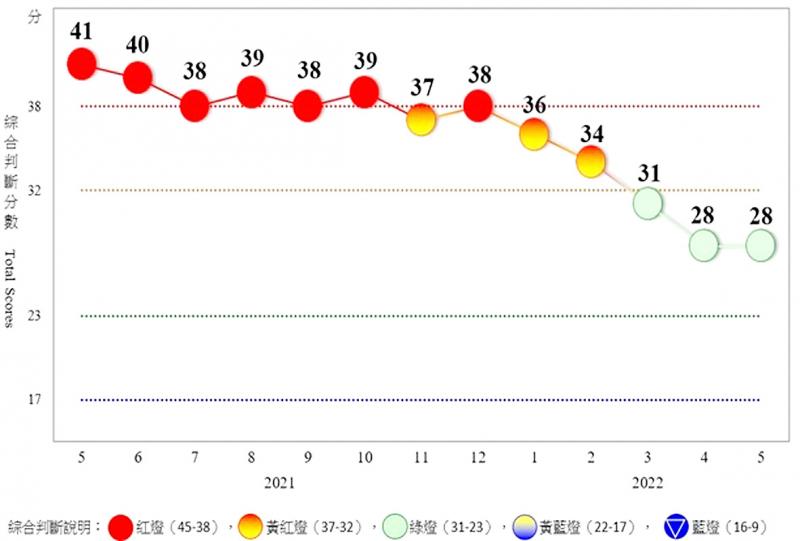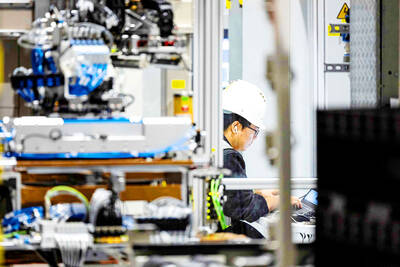Taiwan’s business climate monitor last month signaled green for a third consecutive month, indicating steady growth, after global inflation and China’s COVID-19 controls had weighed on earlier readings, the National Development Council said yesterday.
The total score of nine constituent readings held steady at 28.
However, challenges loom ahead for exports, which have fared well so far, council research director Wu Ming-huei (吳明蕙) said.

Photo courtesy of the National Development Council
The council uses a five-color system to depict the nation’s economic state, with “green” indicating steady growth, “red” suggesting a boom and “blue” signaling a recession. Dual colors indicate a shift to a stronger or weaker state.
Exports account for 60 to 70 percent of the nation’s GDP, as Taiwan is home to the world’s largest suppliers of chips used in smartphones, laptops, autos, and high-performance computing and Internet of Things applications.
Critical economic barometers such as exports, industrial production and export orders have shown signs of a slowdown, but remain in expansion territory, Wu said.
China’s virus controls have disrupted supply chain flows while the Ukraine war has been pushing up international energy and raw material prices — incidents over which Taiwanese firms do not have any control, he said.
Rising inflationary pressures worldwide have taken a toll on global demand for smartphones, laptops, TVs and vehicles.
Domestic demand, on the other hand, might soon come out of the woods, as local semiconductor companies press ahead with capacity expansion plans, which would shore up private investment, Wu said.
The government’s travel subsidies are to take effect next month, by which time the number of locally transmitted COVID-19 cases is expected to have fallen significantly, allowing business activity to recover, he said.
The index of leading indicators, which seeks to project the economic scene in the coming six months, fell 0.7 percent to 99.03, the council said, as almost all sub-indices fell, with the exception of the reading on new construction floor spaces.
The index of coincident indicators, which reflects the current economic situation, shrank 0.56 percent to 100.64, dragged by almost all components except for the gauge on exports, it said.
The gauge on retail sales last month rose from a year earlier, because the government did not tighten social distancing measures this year, as it seeks to live with COVID-19, similar to other countries, Wu said.

CHIP RACE: Three years of overbroad export controls drove foreign competitors to pursue their own AI chips, and ‘cost US taxpayers billions of dollars,’ Nvidia said China has figured out the US strategy for allowing it to buy Nvidia Corp’s H200s and is rejecting the artificial intelligence (AI) chip in favor of domestically developed semiconductors, White House AI adviser David Sacks said, citing news reports. US President Donald Trump on Monday said that he would allow shipments of Nvidia’s H200 chips to China, part of an administration effort backed by Sacks to challenge Chinese tech champions such as Huawei Technologies Co (華為) by bringing US competition to their home market. On Friday, Sacks signaled that he was uncertain about whether that approach would work. “They’re rejecting our chips,” Sacks

It is challenging to build infrastructure in much of Europe. Constrained budgets and polarized politics tend to undermine long-term projects, forcing officials to react to emergencies rather than plan for the future. Not in Austria. Today, the country is to officially open its Koralmbahn tunnel, the 5.9 billion euro (US$6.9 billion) centerpiece of a groundbreaking new railway that will eventually run from Poland’s Baltic coast to the Adriatic Sea, transforming travel within Austria and positioning the Alpine nation at the forefront of logistics in Europe. “It is Austria’s biggest socio-economic experiment in over a century,” said Eric Kirschner, an economist at Graz-based Joanneum

BUBBLE? Only a handful of companies are seeing rapid revenue growth and higher valuations, and it is not enough to call the AI trend a transformation, an analyst said Artificial intelligence (AI) is entering a more challenging phase next year as companies move beyond experimentation and begin demanding clear financial returns from a technology that has delivered big gains to only a small group of early adopters, PricewaterhouseCoopers (PwC) Taiwan said yesterday. Most organizations have been able to justify AI investments through cost recovery or modest efficiency gains, but few have achieved meaningful revenue growth or long-term competitive advantage, the consultancy said in its 2026 AI Business Predictions report. This growing performance gap is forcing executives to reconsider how AI is deployed across their organizations, it said. “Many companies

France is developing domestic production of electric vehicle (EV) batteries with an eye on industrial independence, but Asian experts are proving key in launching operations. In the Verkor factory outside the northern city of Dunkirk, which was inaugurated on Thursday, foreign specialists, notably from South Korea and Malaysia, are training the local staff. Verkor is the third battery gigafactory to open in northern France in a region that has become known as “Battery Valley.” At the Automotive Energy Supply Corp (AESC) factory near the city of Douai, where production has been under way for several months, Chinese engineers and technicians supervise French recruits. “They